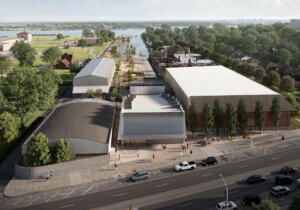The New York-based nonprofit Center for an Urban Future has released a new report sharing more than 40 creative recommendations geared to help small businesses—namely shops, restaurants, and entertainment venues—impacted by the coronavirus pandemic make it through the winter.
Following the initial COVID-related lockdown in New York City, residents and business owners emerged this past spring to a new—and many would say long-overdue—reality in which urban life shifted from climate-controlled indoor spaces to the city’s streets and sidewalks. Outdoor dining, socializing, and socially-distanced community activities brought a vibrancy to many newly pedestrianized streets and, despite some hiccups and continued financial concerns, many businesses adapted and thrived. New Yorkers who didn’t flee the city for less crowded pastures truly made the most of it while helping wounded businesses along their respective paths to recovery.
As winter approaches and outdoor activity becomes seemingly (but not necessarily) less feasible, a handful of architects, planners, restauranteurs, tech and small business experts, retail pioneers, and others have come together to offer their respective ideas as to how to make it work. Those business-sustaining ideas, which include policies and initiatives geared toward city and state policymakers, have been compiled and are presented in the Center’s report, titled “Surviving the Winter: Helping NYC’s Small Businesses in the Months Ahead.”
For example, Claire Weisz, founding principal of architecture and urban design practice WXY Studio, suggested that city officials commence an awning program enabling businesses to continue to operate outdoors during adverse weather conditions. “By working with awning companies to develop a program with a quick and easy permitting process and a set fee to install canvas awnings on building facades, the city can make it easier for local small businesses to install protected outdoor space while creating opportunities for NYC awning and sign companies, too,” explained Weisz in the report.
Weisz also suggested that the city continue to expand bikeways and shared streets so that people, not cars, dominate the urban landscape even during the winter months. By making it easier and safer for pedestrians and cyclists to get around no matter what the season, commercial districts hobbled by the pandemic, particularly in Manhattan, could be revived.
In his recommendations, Vishaan Chakrabarti, founder of Practice for Architecture and Urbanism (PAU), suggested that the city could aid restaurants in erecting scaffolding structures that allow for continued outdoor dining (with a crucial assist from heaters).
“Though some restaurants have already built such structures for the winter, the city can help far more small businesses do so by using sidewalk scaffolding materials to quickly put up cube-like structures,” the report elaborates. “The structure provided by rapid-assembly, scaffolding-style tent enclosures could be built out with a plastic membrane overhead cover and side covers that roll down on at least three sides, trapping the heat within the dining area.”
Chakrabarti also believes that the city’s glut of empty storefronts could be reactivated by populating them with different forms of temporary social infrastructure. “Activity begets activity, so let’s find ways to inhabit empty storefront space with different forms of social infrastructure,” explained Chakrabarti. “The city could get into short-term leases for testing centers, additional classroom space, or vocational training, bringing life and energy back to the streets and helping local businesses in the process.”
Donald Clinton, partner at architecture and urban design firm Cooper Robertson, envisioned large, winterized pavilions that could be used by multiple neighboring restaurants. Semi-enclosed structures would feature natural ventilation and portable electric radiant heaters while fully enclosed ones would feature “forced-air heat and ventilation provided by mobile equipment would provide heat and COVID-safe filtered air.” Individual business improvement districts would oversee the construction and operation of these “lively and dynamic social environments” situated in roadbeds. (Sidewalks would be left clear as would a single traffic lane for cyclists, emergency and service vehicles, and on.)
Jing Liu, co-founder of architecture studio SO – IL, recommended interiorizing select streets in various neighborhoods with assistance from the city as a progression of its Open Restaurant program. “I would like to see a combination of simple greenhouse construction and street closure program to make some streets into temporary arcades like in many European and Australian cities,” she noted.
Matthew Clarke, executive director of the Design Trust for Public Space, proposed that the city initiate a so-called “Warm Streets” program—a sort of cold weather-minded hybrid of its existing Open Streets and Open Restaurants programs. “Similar to “cool streets” which utilize various cooling options to combat heat-burdened parts of NYC, an approach towards “warm streets” could provide heating options in the forms of awnings, heating lamps, and non-metal seating options,” he explained.
Plenty of other novel—and necessary—ideas can be found in the full DoorDash-sponsored report including, and certainly not limited to, embedding designers and experts in under-resourced communities (Deborah Marton, executive director of the Van Alen Institute); loosening limitations on outdoor heater options (Andrew Rigie, executive director of the NYC Hospitality Alliance); launching a food truck-based market in Union Square as well as a city-sponsored winter shelter architecture competition (Andrew Rasiej, founder and CEO of Civic Hall); and establishing contracts between local restaurants and shelters and food pantries (John Wang, founder of the Queens Night Market).











